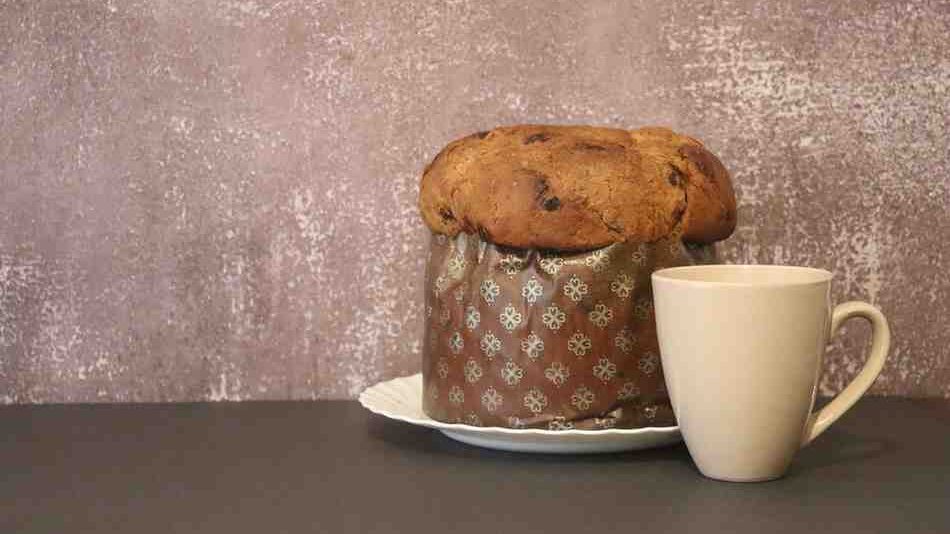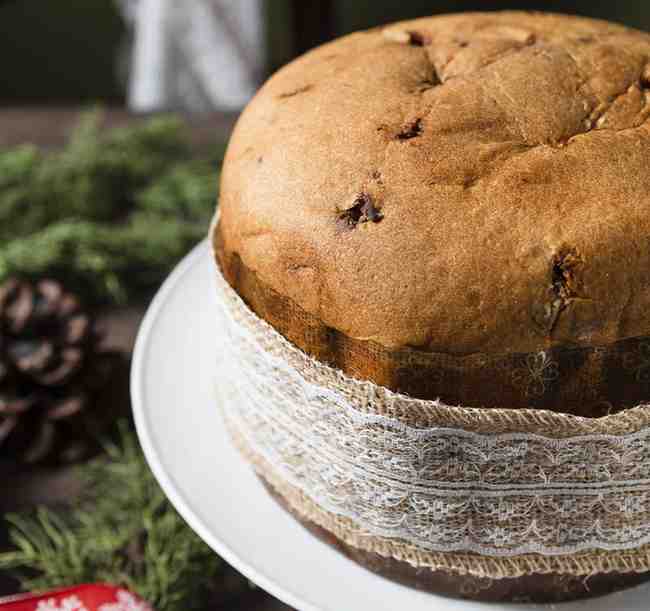Panettone is an iconic Italian Christmas treat, famous for its light, fluffy texture and sweet flavors of dried fruits and citrus. Traditionally, this holiday bread is made with eggs, butter, and milk, which create its rich taste and signature soft structure. But for those following a plant-based diet, making a vegan version of panettone that’s just as indulgent is entirely possible. With the right substitutes, you can enjoy a cruelty-free, delicious, and fluffy vegan panettone that rivals the traditional recipe.
The Challenge of Veganizing Panettone
Creating a vegan version of panettone requires carefully replacing the key ingredients—eggs, butter, and milk—that give the bread its richness and structure. Here’s how we tackle these challenges.
- Eggs: Provide binding and lift.
- Butter: Adds moisture and richness.
- Milk: Helps soften the dough and add flavor.
Replacing these ingredients while preserving the bread’s texture and flavor can be tricky, but with the right substitutes, it’s entirely achievable.
Ingredients for Vegan Panettone
To successfully veganize panettone, you’ll need to use plant-based alternatives that replicate the traditional ingredients. Here’s a breakdown of what you’ll need.
Key Ingredients:
- Vegan Butter: Replaces dairy butter. Use a high-quality plant-based butter or margarine for richness.
- Aquafaba: The liquid from canned chickpeas, used as an egg substitute. It provides fluffiness and binding power.
- Plant-Based Milk: Soy, almond, or oat milk to replace dairy milk. Each adds its unique flavor but keeps the dough soft.
- Yeast: Active dry yeast is essential for giving the bread its rise and airy texture.
- Dried Fruits and Nuts: Raisins, candied orange peel, or almonds for that classic festive flavor.

Flavoring Ingredients:
- Vanilla Extract: Adds warmth and sweetness to the dough.
- Orange Zest: Brings a bright citrus note to balance the richness.
- Amaretto: A splash of this almond-flavored liqueur enhances the festive flavor (optional, ensure it’s vegan).
How Vegan Substitutes Work
To understand how each substitute contributes to the overall result, here’s a look at the roles they play in making your vegan panettone delicious and fluffy.
Vegan Butter
- Role: Adds moisture, softness, and a rich flavor.
- Options: Vegan margarine or coconut oil can be used, but vegan butter tends to give the best result for texture.
Aquafaba
- Role: Replaces eggs by mimicking their binding and leavening properties.
- Preparation: Whip aquafaba (the liquid from canned chickpeas) to a frothy consistency before adding it to the dough.
Plant-Based Milk
- Role: Keeps the dough soft and moist.
- Best Choices: Soy milk provides the most richness, but almond or oat milk works well for lighter textures.
Yeast
- Role: Essential for the dough to rise and develop that classic airy texture.
- Usage: Activate yeast in warm water or plant-based milk with a little sugar before incorporating it into the dough.
Dried Fruits and Nuts
- Role: Add sweetness, texture, and festive flavor.
- Options: Traditional panettone uses raisins and candied peel, but feel free to customize with chopped nuts, cranberries, or even vegan chocolate chips.
Vegan Ingredients Breakdown
Aquafaba: The Magic Egg Replacement
Aquafaba is a key ingredient in vegan baking, particularly for replacing eggs in recipes like panettone. Its starchy consistency binds the dough while providing lift, which is crucial for the bread’s soft texture.
- How to Use: Whip the aquafaba into stiff peaks to create a foamy texture, similar to egg whites. This helps the panettone dough rise and stay fluffy.
- Why It Works: Aquafaba acts as both a binder and leavener, making it ideal for light, airy baked goods like panettone.
Plant-Based Fats: Butter Substitutes
- Vegan Butter: Closest in taste and texture to traditional butter. It provides the necessary fat to keep the bread moist and tender.
- Margarine: A cheaper alternative, but may lack some richness compared to vegan butter.
- Coconut Oil: Adds a subtle coconut flavor, which can complement the other ingredients in panettone. However, it can make the dough slightly heavier.
Adding Flavor with Natural Ingredients
- Vanilla Extract and Orange Zest: Bring warmth and brightness to the dough, balancing the richness of the butter substitutes.
- Amaretto or Rum: Adding a splash of vegan-friendly liqueur can enhance the festive flavor of the panettone. Ensure that the alcohol is vegan-certified if you choose to include it.

Step-by-Step Guide to Making Vegan Panettone
Making vegan panettone is a delicate process, but by following these steps, you’ll be able to create a soft, airy bread that’s perfect for the holidays. This section will guide you through the entire preparation process, from activating the yeast to the final bake.
Step 1: Activate the Yeast
The first step in any yeast-based recipe is activating the yeast. This ensures your panettone will rise properly, giving it that classic light, fluffy texture.
- Ingredients:
- 2 ¼ teaspoons active dry yeast
- ¼ cup warm plant-based milk (soy, almond, or oat)
- 1 tablespoon sugar
- Instructions:
- Warm the plant-based milk (ensure it’s warm, not hot, around 105°F/40°C) and dissolve the sugar in it.
- Sprinkle the yeast over the milk and let it sit for 5-10 minutes until frothy. This means the yeast is activated and ready to work its magic.
Step 2: Prepare the Dough
Once the yeast is ready, it’s time to prepare the dough. This is where the vegan butter, aquafaba, and plant-based milk come into play to replicate the richness of traditional panettone.
- Ingredients:
- 3 cups bread flour or strong flour
- ½ cup sugar
- ½ cup vegan butter, softened
- 3 tablespoons aquafaba (liquid from chickpeas)
- ½ cup warm plant-based milk (plus the ¼ cup from Step 1)
- 1 teaspoon vanilla extract
- 1 tablespoon orange zest
- ½ teaspoon salt
- Instructions:
- In a large bowl, combine the flour, sugar, and salt.
- In a separate bowl, whisk together the softened vegan butter, aquafaba, vanilla extract, and orange zest. Slowly add the activated yeast mixture and the rest of the warm plant-based milk.
- Gradually add the wet mixture into the dry ingredients, stirring until a dough forms.
- Transfer the dough to a floured surface and knead for about 10 minutes. The dough should become smooth and elastic.
Step 3: First Rise
Letting the dough rise is a crucial step in creating the light and fluffy texture of panettone. Vegan dough, like traditional dough, needs time to rise and develop its structure.
- Instructions:
- Place the dough in a lightly oiled bowl and cover it with a clean towel or plastic wrap.
- Let it rise in a warm, draft-free area for 2-3 hours, or until it doubles in size. Patience is key here, as the yeast needs time to do its work.
Step 4: Incorporate Dried Fruits and Nuts
Now that the dough has risen, it’s time to add in the classic panettone fillings, such as raisins, candied orange peel, and nuts. These ingredients add texture and a festive flavor to the bread.
- Ingredients:
- ½ cup raisins or dried cranberries
- ¼ cup candied orange peel (make sure it’s vegan)
- ¼ cup chopped almonds or hazelnuts (optional)
- Instructions:
- Gently knead the dried fruits and nuts into the risen dough, making sure they are evenly distributed.
- Be careful not to deflate the dough too much during this process.
Step 5: Shape and Second Rise
After incorporating the dried fruits and nuts, it’s time to shape the dough and let it rise again. This second rise helps develop the final structure and ensures the bread is light and airy.
- Instructions:
- Shape the dough into a round loaf or divide it into smaller portions if you’re making mini panettones.
- Place the dough in a greased panettone mold or deep paper baking cups. Cover and let it rise again in a warm place for another 1-2 hours, or until the dough reaches the top of the mold.
Step 6: Baking the Panettone
Now comes the most exciting part—baking! The right temperature and timing are essential to ensure your vegan panettone is golden and perfectly cooked inside.
- Instructions:
- Preheat your oven to 350°F (175°C).
- Bake the panettone for 40-50 minutes, or until the top is golden brown and a skewer inserted into the center comes out clean.
- If the top browns too quickly, cover it with aluminum foil to prevent burning while the inside continues to bake.
- Once baked, remove the panettone from the oven and let it cool completely in the mold before serving.
Common Mistakes and How to Avoid Them

Baking vegan panettone can be tricky, but with a few tips, you can avoid common pitfalls and ensure success.
Flat Panettone
- Cause: The yeast didn’t activate properly or the dough didn’t rise long enough.
- Solution: Make sure your yeast is fresh and that the water or milk used to activate it is the right temperature. Let the dough rise fully during both the first and second rises.
Dense Texture
- Cause: Overworking the dough or not kneading it enough can result in a dense, heavy bread.
- Solution: Knead the dough just until it becomes smooth and elastic. Be careful not to overdo it, as this can develop too much gluten and make the dough tough.
Overproofing
- Cause: Leaving the dough to rise too long can cause overproofing, leading to a collapsed bread during baking.
- Solution: Keep an eye on the dough during both rises. The dough should double in size but not over-expand. Stick to the recommended rising times.
Vegan Panettone Variations
While the classic vegan panettone with dried fruits and nuts is delicious, there are plenty of ways to get creative and adapt the recipe to suit different tastes.
Chocolate Hazelnut Vegan Panettone
For a more indulgent twist, swap out the dried fruits for sugar-free chocolate chips and add chopped hazelnuts for a delicious chocolate-hazelnut combination.
- Instructions: Follow the same recipe, but substitute ½ cup of raisins with ½ cup of vegan chocolate chips. Add ¼ cup of chopped hazelnuts for extra crunch.
Gluten-Free Vegan Panettone
If you need a gluten-free version, you can adapt this recipe by using a gluten-free flour blend instead of regular bread flour. Make sure to choose a blend designed for yeast-based recipes to achieve the best results.
- Instructions: Substitute 1:1 gluten-free flour blend for the bread flour. You may need to add 1 teaspoon of xanthan gum for better elasticity in the dough.
Vegan Sourdough Panettone
For those who enjoy a more complex flavor, try making sourdough panettone using a vegan sourdough starter. The process takes longer, but the tangy flavor adds an interesting depth to the bread.
- Instructions: Replace the yeast with ½ cup of a well-fed vegan sourdough starter. Adjust the rising times accordingly, as sourdough rises more slowly than yeast.
FAQs About Vegan Panettone
What Makes Panettone Vegan?
Vegan panettone substitutes eggs, butter, and milk with plant-based alternatives such as aquafaba, vegan butter, and almond or soy milk. These swaps make the bread 100% plant-based without compromising on flavor or texture.
Can I Make Vegan Panettone Without Aquafaba?
Yes, you can use other egg replacements like flaxseed or chia seeds. However, aquafaba tends to give the lightest texture and best results in a recipe like panettone.
How Long Does Vegan Panettone Last?
When stored properly, vegan panettone can last up to 5 days at room temperature. For longer storage, you can refrigerate it for up to a week or freeze it for up to 3 months. Be sure to wrap it tightly in plastic wrap or store it in an airtight container.
Can I Freeze Vegan Panettone?
Yes, vegan panettone freezes well. Wrap the cooled bread tightly in plastic wrap and aluminum foil, then place it in a freezer-safe bag. To serve, let it thaw at room temperature and reheat gently in the oven.
Does Vegan Panettone Taste the Same as Traditional Panettone?
The flavor and texture of vegan panettone can be remarkably similar to traditional panettone. With the right substitutes, you can achieve the same fluffy, light consistency and festive flavor.

